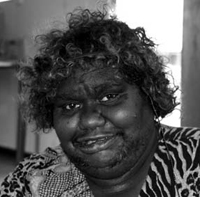BERYL JIMMY
Nyangatja Watarru
13148 (2013)
Acrylic on Linen
200 x 120cm | 78.74 x 47.24in
Tjungu Palya Artists
ENQUIRE
BERYL JIMMY
Nyangatja Watarru
14-410 (2014)
Acrylic on Canvas
150 x 119cm | 59.06 x 46.85in
Tjungu Palya Artists
ENQUIRE
BERYL JIMMY
Nyangatja Watarru
14-243
Acrylic on Belgian Linen
150 x 100cm | 59.06 x 39.37in
Tjungu Palya Artists
ENQUIRE
BERYL JIMMY
Kapi Tjukula
14-196
Acrylic on Belgian Linen
100 x 100cm | 39.37 x 39.37in
Tjungu Palya Artists
ENQUIRE
BERYL JIMMY
Nyangatja Watarru
14-142
Acrylic on Belgian Linen
100 x 66cm | 39.37 x 25.98in
Tjungu Palya Artists
ENQUIRE
BERYL JIMMY
Kapi Tjuta
14-391
Acrylic on Canvas
100 x 66cm | 39.37 x 25.98in
Tjungu Palya Artists
ENQUIRE
BERYL JIMMY
Watarru
PB6-39/40
Silkscreen Print - Edition of 40
84 x 59cm | 33.07 x 23.23in
Tjungu Palya Artists
ENQUIRE
BERYL JIMMY
Kapi Tjukula
16-17BJ
Digital Print - Edition of 50
42 x 52cm | 16.54 x 20.47in
Tjungu Palya Artists
ENQUIRE
Beryl Jimmy is a Pitjantjatjara woman living at the community settlement of Watarru in the far northwest of South Australia, part of an area referred to as the Western Desert.
Beryl's work is inspired by a deep connection to country and her spiritual links to the desert are expressed with integrity, beauty and creativity. Traditional knowledge of food collection and water sources were vital for survival in this dynamic desert landscape and is a prominent theme in her work. This cultural knowledge is handed down orally in the retelling of the Tjukurrpa (traditional stories of the ancestors’ journeys), which not only sustains Anangu (Indigenous people) physically, but socially and spiritually.
Tjukurrpa painting depicts a fragment of a larger story, a living history where an ancestor was involved in creating country. Individuals have authority and ownership of this land and the associated sites and stories. The maintenance of this country is paramount to artists of Watarru and they continue to care and manage the land with respect and responsibility.
Beryl Jimmy is a Pitjantjatjara woman living at the community settlement of Watarru in the far northwest of South Australia, part of an area referred to as the Western Desert.
Beryl's work is inspired by a deep connection to country and her spiritual links to the desert are expressed with integrity, beauty and creativity. Traditional knowledge of food collection and water sources were vital for survival in this dynamic desert landscape and is a prominent theme in her work. This cultural knowledge is handed down orally in the retelling of the Tjukurrpa (traditional stories of the ancestors’ journeys), which not only sustains Anangu (Indigenous people) physically, but socially and spiritually.
Tjukurrpa painting depicts a fragment of a larger story, a living history where an ancestor was involved in creating country. Individuals have authority and ownership of this land and the associated sites and stories. The maintenance of this country is paramount to artists of Watarru and they continue to care and manage the land with respect and responsibility.
![Australian Indigenous (Aboriginal and Torres Strait Islander) artwork by BERYL JIMMY of Tjungu Palya Artists. The title is Nyangatja Watarru. [13148] (Acrylic on Linen)](https://media.redotgallery.com/stockroom/gallery/n/nyangatja-watarru-4112.jpg)
![Australian Indigenous (Aboriginal and Torres Strait Islander) artwork by BERYL JIMMY of Tjungu Palya Artists. The title is Nyangatja Watarru. [14-410] (Acrylic on Canvas)](https://media.redotgallery.com/stockroom/gallery/n/nyangatja-watarru-3581-MEDIUM.jpg)
![Australian Indigenous (Aboriginal and Torres Strait Islander) artwork by BERYL JIMMY of Tjungu Palya Artists. The title is Nyangatja Watarru. [14-243] (Acrylic on Belgian Linen)](https://media.redotgallery.com/stockroom/gallery/n/nyangatja-watarru-3579-MEDIUM.jpg)
![Australian Indigenous (Aboriginal and Torres Strait Islander) artwork by BERYL JIMMY of Tjungu Palya Artists. The title is Kapi Tjukula. [14-196] (Acrylic on Belgian Linen)](https://media.redotgallery.com/stockroom/gallery/k/kapi-tjukula-3578.jpg)
![Australian Indigenous (Aboriginal and Torres Strait Islander) artwork by BERYL JIMMY of Tjungu Palya Artists. The title is Nyangatja Watarru. [14-142] (Acrylic on Belgian Linen)](https://media.redotgallery.com/stockroom/gallery/n/nyangatja-watarru-3577.jpg)
![Australian Indigenous (Aboriginal and Torres Strait Islander) artwork by BERYL JIMMY of Tjungu Palya Artists. The title is Kapi Tjuta. [14-391] (Acrylic on Canvas)](https://media.redotgallery.com/stockroom/gallery/k/kapi-tjuta-3580.jpg)
![Australian Indigenous (Aboriginal and Torres Strait Islander) artwork by BERYL JIMMY of Tjungu Palya Artists. The title is Watarru. [PB6-39/40] (Silkscreen Print - Edition of 40)](https://media.redotgallery.com/stockroom/gallery/w/watarru-4473.jpg)
![Australian Indigenous (Aboriginal and Torres Strait Islander) artwork by BERYL JIMMY of Tjungu Palya Artists. The title is Kapi Tjukula. [16-17BJ] (Digital Print - Edition of 50)](https://media.redotgallery.com/stockroom/gallery/k/kapi-tjukula-4379.jpg)
